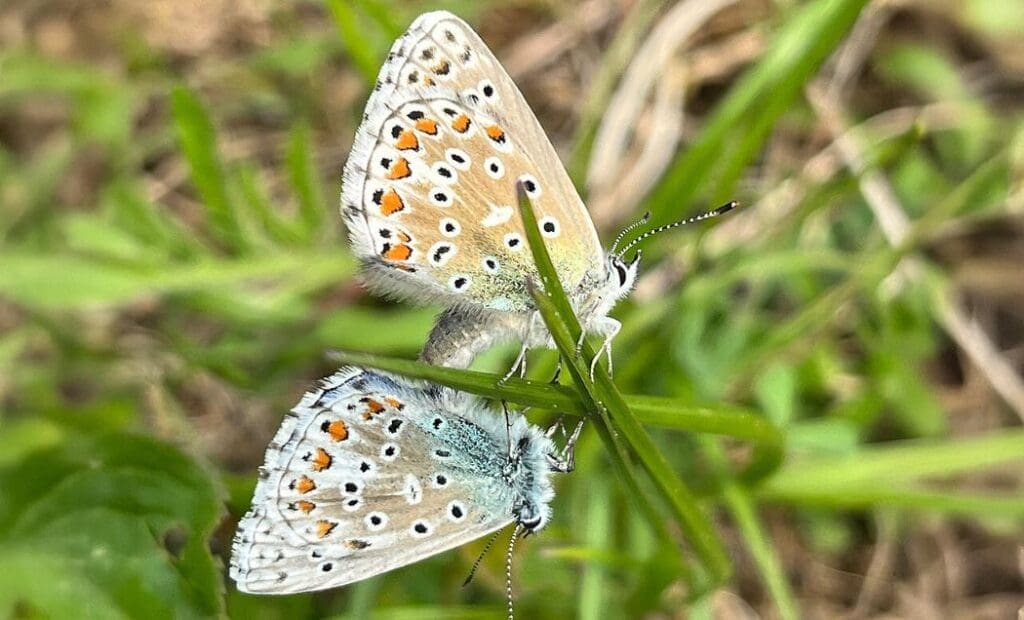Explore the latest insights from top science journals in the Muser Press daily roundup (July 24, 2025), featuring impactful research on climate change challenges.
In brief:
Ecosystem engineers at risk: Underground maps reveal 90% of mycorrhizal fungal biodiversity hotspots lie outside protected areas
- Less than 10% of biodiversity hotspots of mycorrhizal fungi occur in protected areas; 90% are in unprotected ecosystems
- The data powers a new interactive tool, called Underground Atlas, which allows users to explore mycorrhizal diversity patterns anywhere on Earth, offering new ways to see and understand life underground by making hidden fungal biodiversity visible
- Underground biodiversity hotspots occur in the foothills of the Simien Mountains in Ethiopia and the tropical Cerrado savanna in central Brazil. The rarest mycorrhizal fungi occur in West Africa’s Guinean forests and Tasmania’s temperate rainforests
- Maps allow decision-makers to start leveraging mycorrhizal systems to protect underground carbon flows, boost crop productivity, support global biodiversity, and increase ecosystem resilience
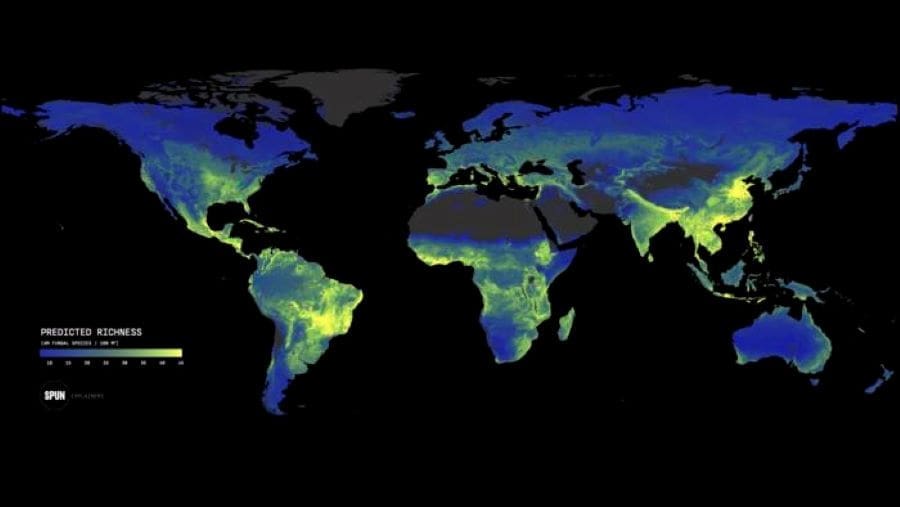
Scientists have released the world’s first high-resolution, predictive biodiversity maps of Earth’s underground mycorrhizal fungal communities, revealing that over 90% of Earth’s most diverse underground mycorrhizal fungal ecosystems remain unprotected, threatening carbon drawdown, crop productivity, and ecosystem resilience to climate extremes.
The research, published in the journal Nature marks the first large-scale scientific application of the global mapping initiative launched by the Society for the Protection of Underground Networks (SPUN) in 2021.
Mycorrhizal fungi help regulate Earth’s climate and ecosystems by forming underground networks that provide plants with essential nutrients, while drawing over 13 billions tons of CO₂ per year into soils – equivalent to roughly one-third of global emissions from fossil fuel. Despite their key role as planetary circulatory systems for carbon and nutrients, mycorrhizal fungi have been overlooked in climate change strategies, conservation agendas, and restoration efforts. This is problematic because disruption of networks accelerates climate change and biodiversity loss.

Using machine learning techniques on a dataset containing more than 2.8 billion fungal sequences sampled from 130 countries, scientists have created the first high-resolution diversity maps to predict mycorrhizal diversity at a 1km2 scale across the planet. Surprisingly, only 9.5% of these fungal biodiversity hotspots fall within existing protected areas, revealing major conservation gaps.
“For centuries, we’ve mapped mountains, forests, and oceans. But these fungi have remained in the dark, despite the extraordinary ways they sustain life on land,” says Dr. Toby Kiers, Executive Director, SPUN. “They cycle nutrients, store carbon, support plant health, and make soil. When we disrupt these critical ecosystem engineers, forest regeneration slows, crops fail, and biodiversity aboveground begins to unravel. This is the first time we’re able to visualize these biodiversity patterns – and it’s clear we are failing to protect underground ecosystems.”
This effort, led by SPUN, brings together GlobalFungi, Fungi Foundation, the Global Soil Mycobiome consortium, and researchers around the world to reveal patterns of fungal richness and rarity across biomes – from the Amazon to the Arctic, and marks a major breakthrough in how we understand and visualize life beneath our feet.
“For too long, we’ve overlooked mycorrhizal fungi. These maps help alleviate our fungus blindness and can assist us as we rise to the urgent challenges of our times,” says Dr. Merlin Sheldrake, Director of Impact at SPUN.
Advancing Earth’s Underground Science
In 2021, SPUN launched with a clear goal: to map Earth’s underground fungal communities with an aim to develop concrete resources for decision-makers, including in law, policy, and conservation and climate initiatives.
“These maps are more than scientific tools – they can help guide the future of conservation,” says Dr. Michael Van Nuland, lead-author & SPUN’s Lead Data Scientist. “Food security, water cycles, and climate resilience all depend on safeguarding these underground ecosystems.”
This work is being guided by a team of prominent advisors including conservationist Jane Goodall, authors Michael Pollan, and author Paul Hawken, and the founder of the Fungi Foundation, Giuliana Furci.

A New Tool for Conservation
SPUN’s findings are now accessible through an interactive tool, Underground Atlas, allowing users to explore mycorrhizal diversity patterns anywhere on Earth. “The idea is to ensure underground biodiversity becomes as fundamental to environmental decision-making as satellite imagery,” says Jason Cremerius, Chief Strategy Officer at SPUN.
Conservation groups, researchers, and policymakers can use the platform to identify biodiversity hotspots, prioritize interventions, and inform protected area designations. The tool enables decision-makers to search for underground ecosystems predicted to house unique, endemic fungal communities and explore opportunities to establish underground conservation corridors.
The maps will also be critical in leveraging fungi to regenerate degraded ecosystems. “Restoration practices have been dangerously incomplete because the focus has historically been on life aboveground,” says Dr. Alex Wegmann a Lead Scientist for The Nature Conservancy. “These high-resolution maps provide quantitative targets for restoration managers to establish what diverse mycorrhizal communities could and should look like.”
Urgent action is needed to incorporate findings into international biodiversity law and policy. For example, the Ghanaian coast is a global hotspot for mycorrhizal biodiversity. But the country’s coastline is eroding at roughly two meters per year. Scientists worry this critical biodiversity will soon be washed into the sea.
“Underground fungal systems have been largely invisible in law and policy,” says César Rodriguez-Garavito, Professor of Law and Faculty Director of the More-Than-Human Life (MOTH) Program at NYU School of Law. “These data are incredibly important in strengthening law and policy on climate change and biodiversity loss across all of Earth’s underground ecosystems”
Global Reach, Local Impact
Together with partners, SPUN has now assembled a dataset of over 40,000 samples comprising 95,000 mycorrhizal fungal taxa. With a global network of over 400 scientists, and 96 ‘Underground Explorers’ from 79 countries, the international team is now sampling the Earth’s most hard-to-access, remote underground ecosystems, including in Mongolia, Bhutan, Pakistan, and Ukraine.
This global effort establishes a critical baseline to understand how these underground communities function and respond to environmental changes. “These maps reveal what we stand to lose if we fail to protect the underground,” says Dr Kiers.
SPUN is seeking new collaborators and funders to scale this work. Currently, only 0.001% of Earth’s surface has been sampled. More data means better maps, more precise restoration benchmarks, and more accurate identification of at-risk underground biodiversity. SPUN invites the public, conservationists, researchers and restoration groups to make use of the Underground Atlas, and provide feedback to help refine future versions.
Journal Reference:
Van Nuland, M.E., Averill, C., Stewart, J.D. et al., ‘Global hotspots of mycorrhizal fungal richness are poorly protected’, Nature (2025). DOI: 10.1038/s41586-025-09277-4
Article Source:
Press Release/Material by Society for the Protection of Underground Networks (SPUN)
Molecular hope: tiny ocean creatures reveal dual paths to climate resilience
Published in the Proceedings of the National Academy of Sciences, the study reveals that it’s not only genetic changes (permanent alterations to DNA) that help these animals adapt to warming and acidifying ocean conditions. In addition, little-known epigenetic changes (temporary “on/off” chemical modifications to parts of DNA) play a crucial role too. Remarkably, the researchers discovered that the two mechanisms operate independently but in concert, offering what they call a “two-pronged strategy” for long-term resilience.
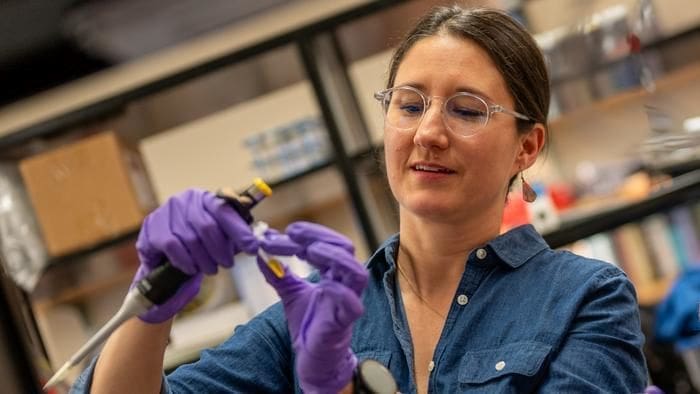
“This is a story of molecular hope in the face of a rapidly changing planet,” said senior author Melissa Pespeni, associate professor of biology at the University of Vermont. “We found that evolution is not working from one toolbox, but two – and they’re complementary.”
Until now, few studies have tracked genetic and epigenetic changes in tandem over many generations. This experiment is one of the first to do so in a long-term, replicated evolution study – offering some of the strongest evidence yet that epigenetic change can help populations survive and perhaps even allow future genetic adaptation.
Which means that copepods may be tougher under the stresses of a warming ocean than scientists previously would have predicted. And that could be good news for the many fish species who eat copepods as their primary prey – and for the many other creatures, including humans, who eat fish.
Evolution in a bucket
To conduct this study, Pespeni and colleagues at GEOMAR Helmholtz Centre for Ocean Research Kiel in Germany and at the University of Connecticut, raised populations of Acartia tonsa – a foundational marine copepod species – in carefully controlled laboratory buckets. Some buckets were warmed, others acidified, and some experienced both. Over a year, these fast-reproducing animals cycled through 25 generations.
The team measured their response not only at the organismal level – how many eggs the copepods laid, their thermal tolerance, development rates, and survival – but also at the molecular level. Using state-of-the-art sequencing, the researchers mapped changes in the animals’ genome (genetic adaptation), epigenome (molecular markers that influence gene expression), and transcriptome (which genes were turned on and off).
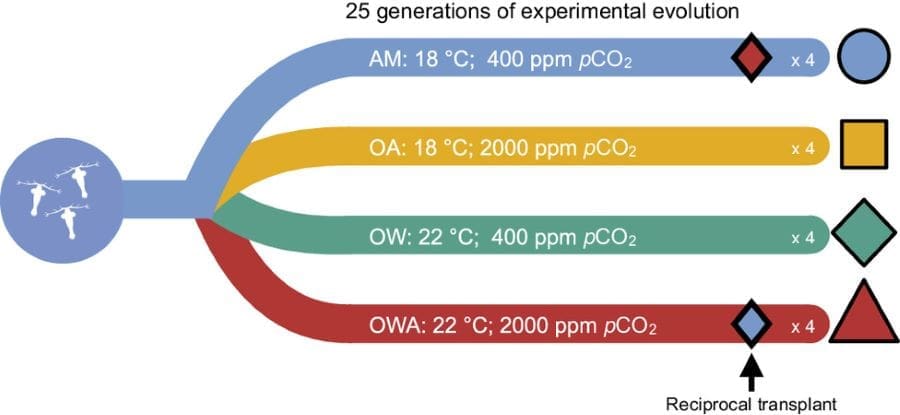
They found striking and consistent epigenetic and genetic changes across the treatment groups – but, surprisingly, these changes occurred in different regions of the genome.
“That’s really powerful,” said Pespeni. “It shows that the epigenetic variation was not just dragged along with the genetic variation. These are independent mechanisms that the organism is using to cope.”
Evolution’s dynamic duo
In genetics, variation provides the raw material for evolution. Populations with more genetic variation are generally better equipped to respond to environmental change. But what happens when genetic variation runs low – or change happens too fast for slow-moving genetic mutations to keep up?
That’s where epigenetics comes in.
“Epigenetic changes can happen within an individual’s lifetime and don’t require a new mutation,” said Pespeni. “They’re reversible and fast.” Exactly what a copepod wants when facing a heatwave or a spike in ocean acidification.
The study found that regions of the copepod genome with high epigenetic divergence – like shifts in methylation – had two to two-and-a-half times lower genetic divergence, suggesting that these mechanisms may inhibit each other or target different functions. But both types of changes mattered.
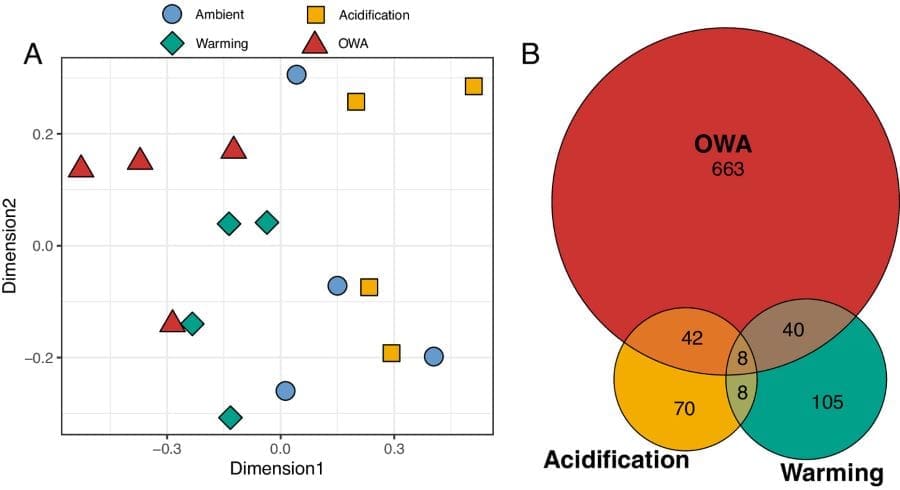
Epigenetic divergence was particularly concentrated in genes involved in stress responses and the regulation of transposable elements – bits of “jumping” DNA that can reshuffle the genome. And importantly, these epigenetic changes were correlated with changes in gene expression, directly shaping how the organism functions.
“Together, these results show that genetic and epigenetic variation are not redundant,” Pespeni explained. “They are evolution’s dynamic duo – providing two independent toolkits for organisms facing rapid global change.”
A shift in evolutionary thinking
The findings have profound implications for how scientists understand evolution and resilience in the Anthropocene.
“Epigenetics is not just a side note in biology,” said Pespeni. “It’s important. We’re not rewriting Darwin, but we are expanding the Modern Synthesis to include this player.”
“This might sound like neo-Lamarckian ‘heresy’,” Pespeni said with a laugh, referencing the discredited idea that traits acquired during a lifetime can be passed to future generations. (Because you spent years in the garden and developed rough calloused hands doesn’t mean your child will be born with “gardener’s hands” or a love of lettuce.) “But what we’re seeing is that molecular and physiological phenotypes – like how an organism responds to temperature stress – can be passed down to future generations through epigenetic means, at least temporarily.”
Why copepods matter
Tiny as they are, Acartia tonsa and other copepods play a massive role in the ocean ecosystem and global carbon cycle. They’re the base of the marine food web, sustaining fish, whales, and seabirds. They also help cycle nutrients and carbon in the ocean.
“Without copepods, you don’t have fish, you don’t have whales, you don’t have the ocean system we know,” said Pespeni. “And they are arguably the most abundant animal on Earth.”
The fact that copepods can survive and quickly adapt across generations – say, during a short, intense heatwave – could make a long-term difference in maintaining biodiversity and ecosystem function in a warming world.
“Allowing an organism to survive a few extra generations during a stress event could preserve genetic diversity and buy time for longer-term adaptation,” said Pespeni.
Hope in the Genome
This research may offer new optimism to the grim tale of global changes. While genetic diversity has long been seen as the well of evolutionary potential, this study suggests that epigenetic diversity might offer a hidden reserve of strength – one that can be tapped quickly, flexibly, and repeatedly. “And that’s important,” Pespeni says, “because it shows these organisms may be more resilient than previously expected.”
Journal Reference:
R.S. Brennan, J.A. deMayo, M. Finiguerra, H. Baumann, H.G. Dam, & M.H. Pespeni, ‘Complementary genetic and epigenetic changes facilitate rapid adaptation to multiple global change stressors’, Proceedings of the National Academy of Sciences U.S.A. 122 (29) e2422782122 (2025). DOI: 10.1073/pnas.2422782122
Article Source:
Press Release/Material by Joshua Brown | University of Vermont
2023 marine heatwaves unprecedented and potentially signal a climate tipping point
The global marine heatwaves (MHWs) of 2023 were unprecedented in their intensity, persistence, and scale, according to a new study. The findings provide insights into the region-specific drivers of these events, linking them to broader changes in the planet’s climate system. They may also portend an emerging climate tipping point.

Marine heatwaves (MHWs) are intense and prolonged episodes of unusually warm ocean temperatures. These events pose severe threats to marine ecosystems, often resulting in widespread coral bleaching and mass mortality events. They also carry serious economic consequences by disrupting fisheries and aquaculture. It’s widely understood that human-driven climate change is driving a rapid increase in the frequency and intensity of MHWs.
In 2023, regions across the globe, including the North Atlantic, Tropical Pacific, South Pacific, and North Pacific, experienced extreme MHWs. However, the causes underlying the onset, persistence, and intensification of widespread MHWs remain poorly understood.
To better understand the MHWs of 2023, Tianyun Dong and colleagues conducted a global analysis using combined satellite observations and ocean reanalysis data, including those from the ECCO2 (Estimating the Circulation and Climate of the Ocean-Phase II) high-resolution project. According to the findings, MHWs of 2023 set new records for intensity, duration, and geographic extent, lasting four times the historical average and covering 96% of the global ocean surface.
Regionally, the most intense warming occurred in the North Atlantic, Tropical Eastern Pacific, North Pacific, and Southwest Pacific, collectively accounting for 90% of the oceanic heating anomalies. Dong et al. show that the North Atlantic MHW, which began as early as mid-2022, persisted for 525 days, while the Southwest Pacific event broke prior records with its vast spatial extent and prolonged duration.
What’s more, in the Tropical Eastern Pacific, temperature anomalies peaked at 1.63 degrees Celsius during the onset of El Niño. Using a mixed-layer heat budget analysis, the authors discovered diverse regional drivers contributing to the formation and persistence of these events, including increased solar radiation due to reduced cloud cover, weakened winds, and ocean current anomalies. According to the authors, the 2023 MHWs may mark a fundamental shift in ocean–atmosphere dynamics, potentially serving as an early warning of an approaching tipping point in Earth’s climate system.
Journal Reference:
Tianyun Dong, Zhenzhong Zeng, Ming Pan et al., ‘Record-breaking 2023 marine heatwaves’, Science 389, 6758, 369-374 (2025). DOI: 10.1126/science.adr0910
Article Source:
Press Release/Material by Walter Beckwith | American Association for the Advancement of Science (AAAS)
Featured image credit: Gerd Altmann | Pixabay




